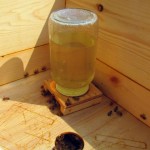Contributed by Dr. Dewey M. Caron
Feeding bees in the fall was brought up by all the SOBA Fall bee course instructors and we got several questions about feeding. Feeding is unquestionably a way to make the difference in whether a colony survives overwinter or not. Feeding does have some potential negatives to also consider.
When colonies are light on food stores, feeding a heavy sugar syrup or leaving stored honey can improve winter survival. It is the best management option to insure the proper fall configuration and promote raising FAT fall bees. To raise Fat bees the colonies need to be FAT with honey.
Karessa, during the opening bee examinations, spoke about “profiling” colonies. It is important to ensure the brood nest is situated low in the colony before fall ends. Ideally, an ample ceiling of honey/syrup will be stored above the brood nest enabling the bees to eat their way up through the overhead stores as winter progresses. If your brood nest is still sitting high up in the colony, she recommend beginning supplemental feeding soon.

Feeding syrup in a Mason jar with tiny holes in the lid. The stand has just enough space for the bees to feed under the jar. (Courtesy of Barbara Jones)
As we heard at the Fall Bee Course, different individuals have different ways to feed and they feed different materials. Basically the BEST way to feed is the one you find useful. Morris prefers to feed syrup in a recycled jar that has a removable lid. He places feeders above the inner cover hole (with a piece of screen material) with an empty super or shell around the feeder. It is easy to check and refill/replace when the bees have taken down the contents. Karessa too feeds the same way.
John feeds his bees in a common feeder in the apiary (feed lot feeding). I like to drill a hole the size of a plastic jar in the lid and put the feeder jar outside the lid. I can remove it and replace it with a filled jar before the bees have a chance to occupy the space of the hole.
Does it make a difference what sugar is fed? Last year The Pacific NW Honey Survey (pnwhoneybeesurvey.com) data says that there was no difference in improvement in loss percentage whether frames of honey, sugar syrup, drivert or fondant is fed. So again personal preference and availability was our recommendation, but for latest fall feeding (and earliest spring) generally a clean, non-contaminated sugar is recommended. Generally fall feeding of protein does not make for a larger colony or improve survival. It does not pay for the cost involved when fed in the fall but it has a valuable role to stimulating colony development by and extending protein available from protein available in the spring
We do recommend that the syrup be mixed heavy in fall feedings. This is to stimulate storage of the material vs stimulating of brood rearing. If “junk” honey is used that is still in a frame, score the cappings to make a “mess” to stimulate the bees to move it into their storage pattern. If you have liquid honey to feed, dilute it and feed in a container feeder within the hive. Be careful when feeding during a drought (often our fall condition) that you do not promote robbing behavior. Reduce entrances and avoid spilling honey/syrup outside of colonies.
Should food stimulants (such as Honey-bee-Healthy, Amino Acid boosters, Pro-Biotics) be used when feeding in the fall? Although they can be good additions to entice the bees into quickly emptying feeders and stimulate healthy colonies, some advocate avoiding adding a food simulant in the fall. If you are debating the value of such additives I suggested you try splitting your colonies into two lots, feeding one and not the other and see if you see a difference. New additives seem to frequently come on the market, but most, adapted from feeding other livestock, have not been extensively or independently tested for effectiveness or potential harmful effects.
John adds vinegar or an acid to his syrup to bring the pH down to around 4.7. At one time, adding something to avoid sugar spoilage and mold growth in feeders was the standard recommendation. Those who feel it important to create a more acidic syrup, thought to better duplicate flower nectars (which have a wide pH range depending upon the flower and plant growing conditions) may help the bees intestinal function. Avoid toxic sugars (such as milk sugars lactose and galactose) and avoid salt, as a higher salt content quickly turns bees off.
Will feeding sugar in the fall make a difference? Those who didn’t feed (in the Pacific NW Honey Survey) lost more colonies than those who did feed. The best advice given at the fall bee school – try it, you might like the improvement in overwintering in your colonies.
